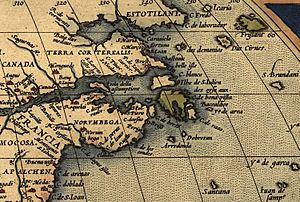Norumbega facts for kids

Norumbega (also spelled Nurembega) is a legendary place in northeastern North America. It was shown on many old maps from the 1500s. People believed it was a rich settlement with houses made of gold and people carrying pearls.
This mysterious place appeared on maps until Europeans started settling the region. It was a big part of the early ideas about the "New World."
Contents
What Was Norumbega?
Norumbega was thought to be a very wealthy town or region. Stories said its buildings had pillars of gold. People there were even believed to carry many pearls. These tales made explorers very interested in finding it.
However, no one ever found Norumbega as described. It remained a legend, inspiring many journeys.
Where Did the Name Come From?
The name "Norumbega" first appeared as Oranbega on a 1529 map by Giovanni da Verrazzano. Experts believe the word comes from one of the Algonquian languages. These languages were spoken by Native American tribes in New England.
The name might mean "quiet place between the rapids." It could also mean "quiet stretch of water." This suggests it might have referred to a calm part of a river.
Norumbega on Old Maps
In 1542, an explorer named Jean Allefonsce claimed he sailed south from Newfoundland. He said he found a large river that he thought was Norumbega. After this, Norumbega often appeared on European maps of North America.
It was usually shown south of Acadia. This area is now known as New England in the United States. The idea of Norumbega helped shape how Europeans saw this part of the continent.
Remembering Norumbega Today
Even though Norumbega was a legend, its name lives on in several places.
- In the 1800s, the city of Bangor, Maine, named its town hall "Norumbega Hall." This honored the old legend.
- In 1886, an inventor named Joseph Barker Stearns built a large house called "Norumbega Castle." It still stands today in Camden, Maine, overlooking Penobscot Bay.
- Later in the 1800s, a professor named Eben Norton Horsford believed Norumbega was a Norse settlement. He thought it was located on the Charles River in Massachusetts.
- Horsford built the Norumbega Tower in Weston, Massachusetts. He claimed this was where "Fort Norumbega" once stood.
- Wellesley College also has a building named Norumbega Hall. It was dedicated in 1886 to thank Horsford for his generous gifts.
- Today, you can find Norumbega Mountain in Acadia National Park. It was once called Brown Mountain.
These names keep the legend of Norumbega alive. They remind us of the early explorations and mysteries of North America.

